For motorists travelling between the Midlands and the port of Felixstowe on the Suffolk coast, the completion of the A14 improvement project cannot come too soon.
One of the most congested routes in the country, the A14 carries an estimated 85,000 vehicles per day – far more than it was designed for – and journey times are notoriously slow.
Currently Highways England’s biggest road-building project, the £1.5bn upgrade of a 21-mile stretch of the A14 between Huntingdon and Cambridge is run by an ‘Integrated Delivery Team’ (IDT) comprising Highways England, its designers Atkins and CH2M, and two Tier 1 joint venture contractors, Costain/Skanska and Balfour Beatty/Carillion. The latter is now simply Balfour Beatty, for well-publicised reasons.
The scheme includes a new bypass to the south of Huntingdon, widening of sections of both the existing A14 and A1 trunk roads and the construction of new local access roads.
The project also calls for numerous bridges – 34 in total – along the route, carrying the new road over waterways, railway lines and local roads, as well as bridges over the A14 itself.
Partly for reasons of economy and speed of installation, the majority of these structures are of steel construction. At the very earliest stages in the design process the joint venture contractors carried out a value-engineering exercise to find the optimum methods of construction.
The conclusion was that any bridge of 40 metres span or more would be built out of steel.
Cleveland Bridge has the contract to supply six of the largest bridge structures on the route, including the largest, a 750m-long viaduct spanning the River Great Ouse and a large area of bordering flood plain on each bank.
Two of these six structures, the BN03 Brampton Interchange bridge and the BN06 bridge over the East Coast Mainline, were completed earlier this year; steelwork for the Great Ouse viaduct (structure BN05) was completed in August. Two more bridges, the BN20 and BN21 Bar Hill Junction bridges, were installed at the beginning of September.
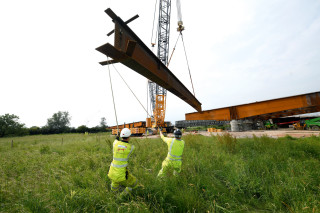
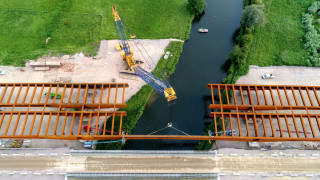
The last bridge, BN27, is the A1/A14 interchange bridge, also at Brampton. This is scheduled for completion early next year.
The completion of the B05 viaduct structure marked a milestone in the project. The bridge, which carries the Huntington bypass section of the new road across the river, just 100m or so to the west of the East Coast Mainline, contains 6,000 tonnes of steel comprising 76 main beams and 800 cross-girders.
The main beams are supported on 16 pairs of concrete piers and are between 35m and 40m in length and 2m deep, each weighing approximately 50 tonnes.
The eight beams forming the 70m span over the river itself are the largest pieces of steelwork on the project. These are complex tapered beams weighing up to 95 tonnes apiece and varying in depth from 3m at the centre to 4.2m at the ends.
“These are very substantial girders,” says Michael Whinn, project manager for Cleveland Bridge, who says that their shape made them especially difficult to handle. “They were a real problem to get to site.”
Haulier Prestons of Potto had the contract to deliver the steelwork to site from Darlington. Because of their taper, the viaduct’s big main beams were transported lying on their sides and had to be ‘flipped’ over when they arrived on site, says Whinn.
“We designed special lifting claws to latch onto the flanges that enabled the crane to rotate the girders and then lift them into place,” he explains.
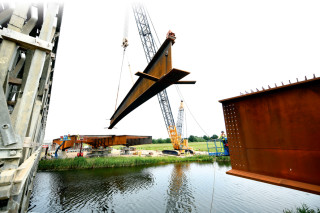
The crane employed was a 600-tonne- capacity Demag CC2800-1 crawler from Ainscough Crane Hire, which arrived on site in November 2017 and remained in service until May this year, when most of the heavy lifting had been done.

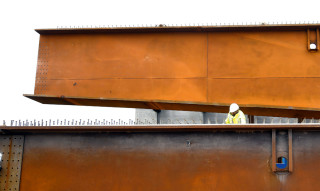
The main benefit of using such a large crane was that no other lifting equipment was required while it was on site. Positioned on a specially-constructed platform, the crane was able to complete the whole series of lifts from a single location.
After the big crawler was off-hired, Ainscough replaced it with a smaller telescopic mobile crane to carry out the remaining lifting operations.
Bridge BN03, the A1 Brampton interchange bridge, was completed at the beginning of the year and, while much smaller than the viaduct, is also a complex structure. “This bridge is both curved and cambered…it took a lot more time to design and fabricate,” says Whinn.
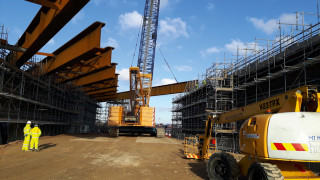
This 80m-long bridge contains approximately 1,400 tonnes of steel including 30 curved and cambered beams up to 34m in length, designed using Tekla Structures computer modelling software. Installation was also tricky, as the complex girders had to be delivered individually and then spliced together on site. Cleveland Bridge developed a special jacking system to enable the accurate assembly of the steel sections.
The other bridge completed at the beginning of this year is BN06, the bridge over the East Coast Mainline, just 100m east of the viaduct. This structure consists of five pairs of beams, each 40m long and weighing 85 tonnes. The challenge here was the strict possession periods during which the bridge could be constructed.
“Once you start dealing with Network Rail, you’re into a strenuous planning process,” comments Whinn. “We installed the bridge over three consecutive Saturday nights. The line was closed at midnight and opened again at six o’clock on Sunday morning. There is no flexibility – you can’t over-run at all – but we planned it so that we were confident we could complete our work well within the window.”
This month [September] sees the installation of two of Cleveland Bridge’s three remaining structures. These are BN20 and BN21, two identical 47m-long bridges replacing an existing bridge carrying local traffic over the widened A14 at Bar Hill.
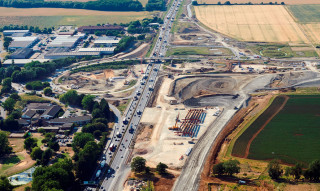
These bridges have been completely assembled in a yard alongside the road and are temporarily supported on steel trestles. On 17th September, a modular self-propelled trailer supplied by heavy-lift specialist Mammoet will lift each bridge in turn, carry it onto the A14 (which of course will be closed temporarily) and then transport it down the road to the prepared abutments. The entire operation is expected to be completed the same day.
With the exception of the enormous viaduct, all of the A14 bridges were trial-erected at Cleveland Bridge’s yard in Darlington prior to delivery to site. “The tolerances are tight, but not really any greater than usual,” says Whinn. “However some of the details are complex and difficult to fabricate.”
Building in steel has enabled the Integrated Delivery Team to speed up programme times with pre-engineered, lightweight structures for all the major bridges. According to Whinn, BN06 (the East Coast Mainline bridge) would have had to be built from steel even if it were less than 40m in length, since only steel could deliver the low profile necessary to achieve the required headroom.
And the value-engineered design of the viaduct, which includes a precast concrete deck fabricated at the IDT’s yard at nearby Brampton, simplified installation making it safer and reducing costs by an estimated £4m.
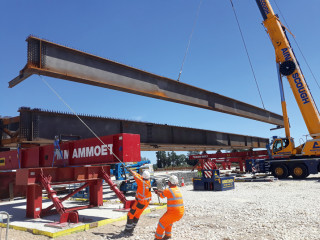
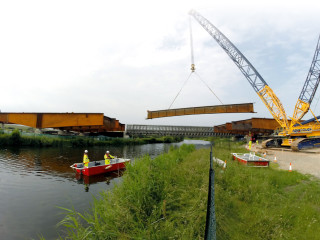
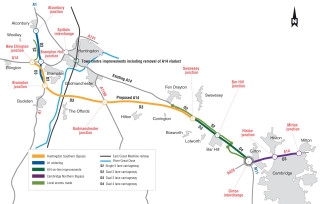
This article was first published in the September 2018 issue of The Construction Index magazine
UK readers can have their own copy of the magazine, in real paper, posted through their letterbox each month by taking out an annual subscription for just £50 a year. Click for details.
Got a story? Email news@theconstructionindex.co.uk


